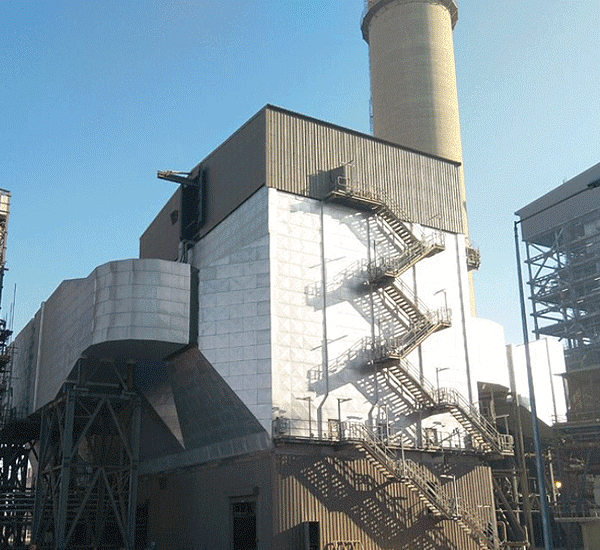ESP
The electrostatic precipitator, with its countless possible applications, is to date the most economical method for the dedusting of gases. Firstly, it requires little energy compared to other systems and secondly, the maintenance and spare parts costs are very low. In addition, the lifespan of an electrostatic precipitator usually exceeds the upstream production equipment such as furnaces, boilers and mills. Since it does not add much pressure drop in the flue gas, retrofitting an ESP into an existing stream is possible without major upgrades to the fans or blowers and other equipment.
The basic principle of ESP operation is the ionic charging of particulate matter such as flyash, catalyst fines, fugitive dusts etc. Discharge electrodes that are fed with rectified negative high voltage emit electrons creating a corona effect around the emitting points.
Particles entering these corona fields are charged by the emitted electrons and therefore attracted to the earthed collecting electrodes under the influence of the resulting electric field. An ESP consists of a series of discharge electrode and collecting electrode banks arranged in both series and parallel to create the treatment zone for the flue gas.
Periodically, the particulate collected on the collecting electrode of a dry ESP is dislodged by a process known as rapping. The dislodged dust is allowed to fall into the collection hoppers situated below the ESP treatment zone, from where it is discharged via means of a dust conveying system. The discharge electrodes are also similarly cleaned periodically, though on a lower frequency when compared to the collecting electrodes.
Rapping in dry ESPs is carried out in two ways; either by means of a series of hammers that are mounted on a slowly rotating shaft (tumbling hammer design), or by using a Magnetic Impulse Gravity Impact (MIGI) rapping system. Harmony Environmental Systems is one of the few OEM’s to offer both rapping options to our customers, allowing us to customize our design to the specific requirements of the application and needs of the customer. Our HARMONY-E series ESP utilizes the high-reliability MIGI rappers, while our HARMONY-M series ESP utilizes the tumbling hammer arrangement.
The selection of the rapping system is followed by finalizing the type of Collecting and Discharge electrodes suitable for the service. Our ESPs are equipped with either the class leading High-G type collecting electrode especially suitable for high reliability and low emission environments or the Magna type split plate electrode, which offers ease of transport and constructability while offering excellent dust collection attributes. Discharge electrodes provided are exclusively rigid type with the number and spacing of emitting points customized based on the application and the specified outlet emissions requirements.
The third major equipment selection concerns the power supply. HES has references using both single phase and three phase T/R sets as well as the more advanced high frequency switch mode based power supplies.
No matter the ESP model specified, with Harmony, you are guaranteed an ESP design with reliability and ease of operation and maintenance at the top of the design requirements.
HES offers you an ESP solution for customized to your application and requirements.. Continuous optimisation and further development, integrating the latest technologies, as well as the real-time incorporation of ESP data under many different operating conditions, have yielded an immeasurable wealth of experience. With HES, you choose a system that incorporates unrivalled know-how.

